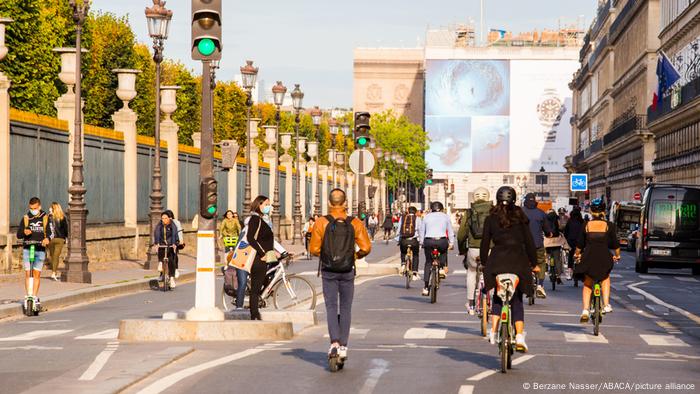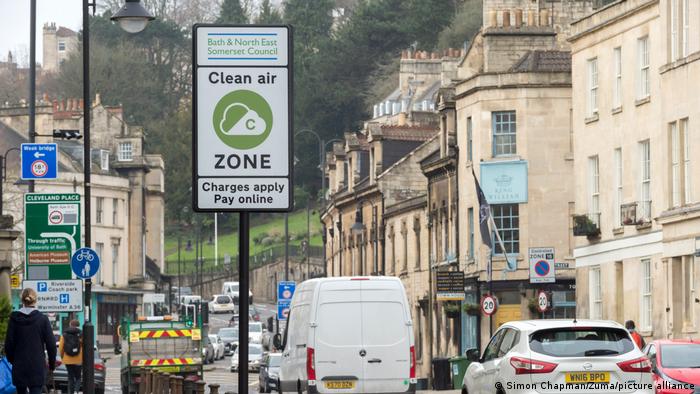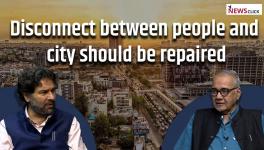Cities are Major Polluters: Can We Make Them Climate Neutral?
Around 85% of humanity will be living in cities by 2100. Many will inhabit sprawling megacities of more than 10 million people. But these urban jungles are climate killers. Built with high-emission steel and concrete, powered and heated with oil, coal and gas; cities are responsible for around 75% of global CO2 emissions.
The latest UN report proposing ways to address the climate crisis made special mention of cities. Urban building emissions — both operational and during construction — have risen by around 50% since 1990, according to the report. This means the sector must rapidly decarbonize if global heating is to remain within 1.5 degrees Celsius (2.7 degrees Fahrenheit) above 1990 levels.
Urban emissions could be reduced to near zero by 2050 if cities are powered by renewables, buildings are insulated and made energy-efficient, and transport is electrified. Greening cities will also capture CO2 and help combat deadly heat-trapping effects that are particularly problematic in large metropolises.
But around 60% of the buildings that will make up cities in 2050 are yet to be constructed, meaning the dream of the climate-neutral city, with very low to zero emissions, is within reach, say experts.
Cities can lead on climate mitigation
Cities can be a microcosm of successful climate mitigation, says Rogier Vandenberg, acting global director of the Ross Center for Sustainable Cities at the World Resources Institute, a US-based non-profit.
"A huge opportunity lies in cities due to the huge concentration of people, meaning you can decarbonize at scale," he said. "The solution is in cities."
But significant challenges remain, primarily in creating a shift to high-density, compact cities with people living closer together and reducing the need for cars. According to one popular metric, the goal is to be able to reach all amenities by foot or bicycle within15 minutes.
Parisians live the dream of the 15-minute city during the pandemic as they abandon cars and even public transport in favor of cycling
Experiments have already taken place in the wake of the pandemic to reduce travel time and enable people to live and work locally, including Melbourne's 20-minute neighbourhoods and the Paris 15-minute city.
"We've already known for decades that cities function better, are cleaner, more sustainable, more equitable, if you create services in the proximity of where people live," said Vandenberg.
A new urban planning vision
But this will require a bold urban planning vision that shifts away from the horizontal sprawl evident in many major global cities. "You really have to think differently about how you plan, how you retrofit cities," said Vandenberg.
Equitable access to efficient, electrified urban transport will also also be fundamental if poorer urban communities are to be transformed into climate neutral cities.
Citizens in low-income countries currently spend around 35% of their income on transportation, partly because of urban sprawl and a lack of access to housing in areas where people work, noted Vandenberg.
The Ross Center for Sustainable Cities, which aims to support climate neutrality in cities by 2050, is partly focused on the electrification of urban transport, including buses, in fast-growing African cities. The digitization of transport infrastructure will also be key in the effort to better fit transport availability to the needs of commuters.
But while transport is responsible for 20% of city emissions, according to Vandenberg, the elephant in the room remains buildings, which emit three times as much carbon.
More capital market and investor support is needed to construct low-emissions buildings and retrofit others to improve energy efficiency, he explained.
This includes universal standards for sustainable buildings that will inspire investment from pension funds and others looking to decarbonize their portfolios.
The benefits for the economy also need to be better understood. "Currently, the most jobs per million dollars invested is in retrofitting buildings," said Vandenberg.
Europe aims for carbon neutral cities by 2030
In European cities like Copenhagen, the dream is already being realized. The Danish capital is on track to be climate neutral by 202 billion) for an average city of 100,000 people to become climate neutral by 2030. Help in accessing finance and know-how will be5, working over 10 years to remove the city's 2 million-ton annual carbon footprint through a new smart renewable energy grid.
Meanwhile, a program has been launched to make 100 European Union cities climate neutral and smart by 2030. The ultimate objective is to achieve climate neutrality across all cities by 2050.
Estimates by Material Economics, a Swedish sustainability consultancy, suggest that the cost could be as high as €1 billion ($1.1 provided by the EU consortium, Net Zero Cities.
A Clean Air Zone enforces low exhaust emission standards in the city of Bath in the UK
Healthier cities
With 85% of Europeans estimated to be living in urban areas by 2050, city mayors are realizing the "co-benefits" of climate neutrality, including cleaner air, improved citizen health and reduced noise pollution, said Matthew Baldwin, manager of the EU 100 Climate Neutral Cities project.
"People who live in cities are very climate conscious," he added. This is in part because urban dwellers see the costs of pollution firsthand. Many cities are also built on ports and are threatened by rising seas.
The EU's bottom-up climate neutral program engages with citizens to make them more aware of the co-benefits of climate action. "You can't do a climate neutral project unless you engage with citizens," said Baldwin. Such awareness extends to the need for energy independence in the wake of the war in Ukraine, both through upscaling renewable capacity and building efficiencies that can be quickly implemented.
"The European Commission is looking at all ways in which we can urgently switch our energy out of Russian hyrdrocarbons into renewables," said Baldwin. "What better place to start than cities, due to the density of their populations. You have shorter distances to travel in cities, it's easier to switch to public transport, walking, cycling and electromobility."
'Cities can go further and faster'
Cities globally are ramping up their ambition to become climate neutral in line with, and sometimes ahead of, the Paris Agreement emissions targets.
Some 30 cities already hit peak emissions by 2020 as part of the C40 Cities initiative that aims to support thousands of cities in becoming net zero by 2050 — among them Athens, Austin, Barcelona, Berlin, New York City, San Francisco, Los Angeles, Stockholm and Warsaw.
"Running our cities on renewable energy is the bedrock upon which an equitable, zero-carbon economy is built," said Eric Garcetti, chair of C40 and mayor of Los Angeles, last September. Already powered by 40% renewables, Los Angeles will reach 80% by 2030. A 100% clean energy grid is on targeted for 2035, while a full coal phase-out will see the last plant converted to hydrogen.
"Cities can go further and faster than nations as a whole," said Baldwin. "I feel we're going to go a lot quicker than we think.
Edited by Jennifer Collins
Get the latest reports & analysis with people's perspective on Protests, movements & deep analytical videos, discussions of the current affairs in your Telegram app. Subscribe to NewsClick's Telegram channel & get Real-Time updates on stories, as they get published on our website.


























